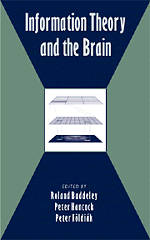Part Three - Information Theory and Psychology
Published online by Cambridge University Press: 04 May 2010
Summary
the relevance of information theory to psychology depends a bit on what you think psychology is about. Since this book is about the relationship betwen IT and the brain, it could be argued that the whole of it is relevant to psychology. If you are of the school that thinks the only real psychology is clinical, then IT has rather little to offer as yet, though it is making inroads even there: Germine (1993) describes a model of the physiology of the mind as an informational system. It is probably no coincidence that all three of the editors of this volume work in psychology departments. Our interests are all rather in the area of perception: how things may be represented in the brain and how those representations come to be formed. Much of the rest of the volume concerns such things: this part concerns some attempts to apply information theory to other aspects of behaviour.
Janne Sinkkonen (Chapter 13) argues that the amount of processing an input receives will depend upon its importance to the organism, which he identifies with its unexpectedness. He shows that this assumption leads to an identity of form in the equations used to describe the theoretical information content of the message and the resource allocation by the organism. The principle resource to be allocated is energy. An experiment to test these ideas with human participants is reported. A device is used that can measure the EMF generated from postsynaptic currents in the brain, which, potentially, indicate energy consumption. The participants are played a sequence of two tones, where one occurs with lower probability than the other.
- Type
- Chapter
- Information
- Information Theory and the Brain , pp. 201 - 203Publisher: Cambridge University PressPrint publication year: 2000

